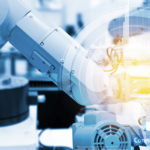By Mark Jones
“Scientists find about a quarter million invisible nanoplastic particles in a liter of bottled water” was a recent AP headline. It was one of hundreds of stories prompted by a recent scientific publication. In a first in this column, I’ll give you some fun experiments you can do with the water. You’ll be able to determine what choices have the fewest particles if you desire to reduce particle exposure. Whether you should — will have to wait for another column.
 The Proceedings of the National Academies of Science (PNAS) in January published work from Columbia and Rutgers using a Raman technique to identify particles in commercial bottled water samples. The technique requires filtering the water to make imaging possible. The Raman technique allows the chemical composition of the particles to be determined and counted. The paper got noticed, largely for estimating micro- and nanoplastic levels in commercial bottled water of 2.4 ± 1.3 × 105 particles per liter. 90% were previously undetected plastic nanoparticles.
The Proceedings of the National Academies of Science (PNAS) in January published work from Columbia and Rutgers using a Raman technique to identify particles in commercial bottled water samples. The technique requires filtering the water to make imaging possible. The Raman technique allows the chemical composition of the particles to be determined and counted. The paper got noticed, largely for estimating micro- and nanoplastic levels in commercial bottled water of 2.4 ± 1.3 × 105 particles per liter. 90% were previously undetected plastic nanoparticles.
Few readers will have a Raman microscope sitting around, but many will have a flashlight, a laser pointer and a camera (all you need to measure micro- and nanoparticles in liquids). In the 84 references in the Raman paper, they omitted one from the University of Minnesota. Ye and Pui published “Detection of nanoparticles suspended in a light scattering medium” in 2021. They offered a means to image both the micro- and nanoparticles present in bottled water without opening the bottles. That’s right, they counted particles in sealed bottles, right off the shelf. They measured total particles at about 107 per liter, more than the recent study. These surely include plastic, but also can be inorganic or biological particles.
Glance at a glass or bottle of water and you might not see anything. Get a bright flashlight, preferably one that allows tight focus of the beam, as many “tactical” style LED flashlights do these days. Stir the water, but don’t shake or stir so hard that you make bubbles of air. Bubbles look like particles. Shine focused light through the water and look perpendicular to the beam. You will very likely see particles moving in and out of the light. Many samples will look like a sparsely filled snow globe with magnification. Nanoparticles can’t be seen under normal conditions because they are smaller than the wavelength of visible light. Laser irradiation changes that. The intense incident electric field prompts visible Rayleigh scattering. The 5-mW red and green lasers used are commonly available as laser pointers. Look perpendicular to the beam going through your water sample and particles will look like bright spots. Nanoparticles don’t show up well with red, but microparticles do. Green makes both visible. Comparing red and green images gives a comparison between micro- and nanoparticle levels. Aim the laser through the water bottle and snap a photo perpendicular to the beam. Count the bright scattering in the beam and apply some math, approximating the beam as a cylinder, to get the number in the beam volume.
I find there are hundreds to low thousands of microparticles per liter in bottled water. I’ve fished out the microparticles. They look like plastic under the microscope, likely there from filtering and other handling equipment. Like Ye and Pui, I find millions of nanoparticles per liter. Don’t stop at bottled water. Check other beverages. I find particles in liquor and wine, all packaged in glass.
Should you be concerned about plastic micro- and nanoparticles, consider yourself armed. You can check before you drink — and make informed choices.
You may also like:
Filed Under: NEWS • PROFILES • EDITORIALS, Commentaries • insights • Technical thinking







